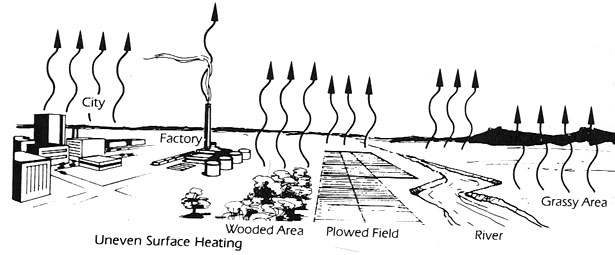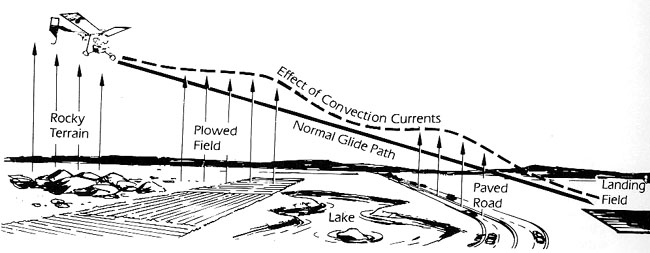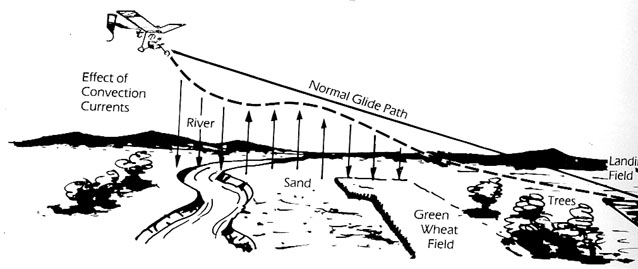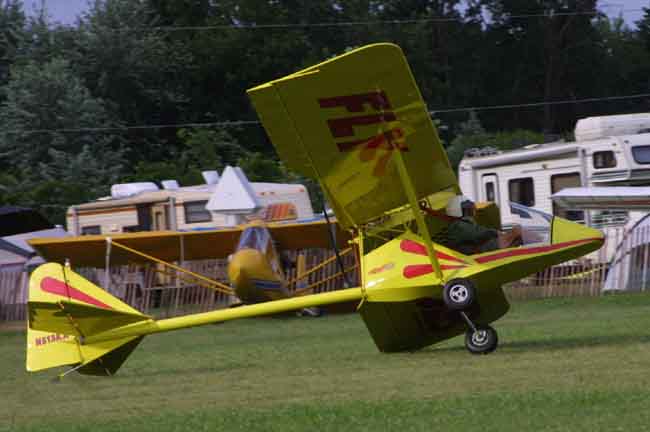| The location was a 2000 ft sod strip with very tall
7-8 foot corn growing along both sides of the runway.
The wind was 7-10 mph approximately directly across
the runway. Of course with the tall corn there was
almost no wind right down on the runway.
The aircraft was a scratch-built VW powered tail dragger
very much like the N3-Pup. The pilot and builder had
flown the plane into the strip for a local fly-in.
Throughout the day traditional ultralights and GA planes
made takeoffs and landings at this strip in both directions.
It was mildly bumpy but no one, not even the 2-axis types,
had any real problems.
When the pretty little homebuilt tail dragger began it's
takeoff, the wind had shifted to a slight quartering
tailwind. As soon as the plane rose above the corn
the upwind wing lifted and the plane began to sink. It
drifted off the runway, sank into the tall vegetation,
and then came to a stop facing backwards. The pilot
was not injured, but the plane in nearly totalled. There
was no malfunction of the airframe or the engine.
The aircraft was a scratch-built VW powered tail dragger
very much like the N3-Pup. The pilot and builder had
flown the plane into the strip for a local fly-in.
Throughout the day traditional ultralights and GA planes
made takeoffs and landings at this strip in both directions.
It was mildly bumpy but no one, not even the 2-axis types,
had any real problems.
When the pretty little homebuilt tail dragger began it's
takeoff, the wind had shifted to a slight quartering
tailwind. As soon as the plane rose above the corn
the upwind wing lifted and the plane began to sink. It
drifted off the runway, sank into the tall vegetation,
and then came to a stop facing backwards. The pilot
was not injured, but the plane in nearly totalled. There
was no malfunction of the airframe or the engine.
It's a shame to wreck such a pretty plane this way.
The lesson is especially important for GA pilots who are
switching to ultralights. You want to have plenty of
extra airspeed anytime you fly through that last 75 feet
above the ground. Zoom through it, going up or down.
You can't forget about the wind and the air even once. Also
wake turbulence must be always on our mind. This incident
supports the notion that pilots should be introduced to
downwind takeoffs.
They _will_ do it someday.
dan (zoom through it) grunloh
Daniel Grunloh (grunloh@uiuc.edu)
http://www.staff.uiuc.edu/~grunloh
Table 7n-1:
Beaufort wind speed scale.
|
Beaufort
Code |
Speed
Miles
per Hour |
Speed
Kilometers
per Hour |
Description
|
Effects on the Environment
|
|
0
|
1
|
1
|
calm
|
smoke
rises vertically |
|
1
|
2 -
3
|
1 -
5
|
light air
|
smoke
drifts slowly |
|
2
|
4 -
7
|
6 -
11
|
light breeze
|
leaves rustle, wind can be felt, wind vanes move |
|
3
|
8 -
12
|
12
- 19
|
gentle breeze
|
leaves and twigs on trees move |
|
4
|
13
- 18
|
20
- 29
|
moderate breeze
|
small
tree branches move, dust is picked up from the
ground surface |
|
5
|
19
- 24
|
30
- 38
|
fresh breeze
|
small
trees move |
|
6
|
25
- 31
|
39
- 51
|
strong breeze
|
large
branches move, telephone and power overhead
wires whistle |
|
7
|
32
- 38
|
51
- 61
|
near gale
|
trees
move, difficult to walk in the wind |
|
8
|
39
- 46
|
62
- 74
|
gale
|
twigs
break off from trees |
|
9
|
47
- 54
|
75
- 86
|
strong gale
|
branches break off from trees, shingles blown
off roofs |
|
10
|
55
- 63
|
87
- 101
|
whole gale
|
trees
become uprooted, structural damage on buildings |
|
11
|
64
- 74
|
102
- 120
|
storm
|
widespread damage to buildings and trees |
|
12
|
75
|
120
|
hurricane
|
severe damage to buildings and trees |
|






